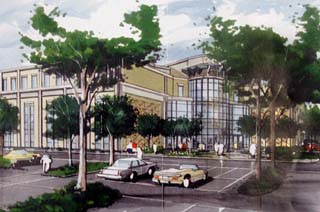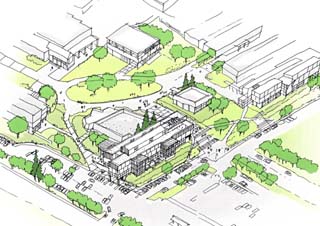
DJC.COM
August 20, 2002
State’s two-year colleges face a space crunch
SBCTC

Courtesy of BJSS Duarte Bryant Architecture Snoqualmie Hall, at Edmonds Community College in Lynnwood, will provide space for students who wish to complete their four-year degrees close to home. The $17.4 million building, designed by Seattle’s BJSS Duarte Bryant Architecture and now under construction by Spee West Construction Co. of Edmonds, opens this fall. |
It’s no secret that the nation is experiencing a significant shortage of nurses and other health care workers, or that schools are in desperate need of math and science teachers.
But not everyone realizes that the state’s 34 community and technical colleges are part of the solution. They provide training in most of the key areas of shortage identified by the state hospital association, and nearly half of teachers in this state begin their higher education at two-year colleges.
In fact, more than 40 percent of the students earning bachelor’s degrees in this state start at a two-year college. Most need a series of lab science courses to complete transfer requirements, and science and engineering majors need even more.
A major stumbling block is the lack of facilities for the required science and health occupations courses. The two-year college system is serving far more students than their campuses were built to serve and too many of the buildings are old, poorly constructed, inadequate and lack sufficient space.
|
Many of the colleges are seeking funding to replace outmoded buildings for teaching science and health occupations, among other projects. The community and technical college system’s $457 million request to the Legislature (see sidebar) includes facilities for offering these courses and programs in numerous communities across the state.
High-priority requests to plan, renovate or construct science or health occupations facilities have been identified by nearly every college.
Olympic College is asking for $22.6 million for a new science and technology center; Everett Community College needs $7.3 million to reconfigure and expand chemistry and physics labs and classrooms; and Columbia Basin College is requesting $6 million to renovate and add on to an existing building, creating a medical technology center in the process. And that’s just to name a few.
Spokane Community College, which completed construction of an addition that doubled the size of its health sciences building last year, clearly demonstrates what new facilities mean to the college and the community.
“We’ve been able to move the training programs into one building and bring the equipment together so students from multiple programs can share it,” said Carol B. Riesenberg, dean of instruction for health and environmental sciences at SCC. “We were also able to bring the equipment up to industry standards.”
The college updated and expanded skills labs, so students in nursing and dental assisting, for example, are able to learn in appropriate environments. The building now includes computer labs where students can do research and generate reports.
“It’s been an amazing improvement,” she said.
“With the larger labs we’ve been able to increase enrollment in some programs, although funding to offer the classes is a problem. We worked with a local consortium to arrange the funding to add 20 nursing students per year for two years,” Riesenberg said. This couldn’t have been done without new facilities.
Spokane’s health science building houses 17 different health occupations programs. In addition to nursing, the college offers emergency medical technician, paramedic, cardiovascular technology, pharmacy technician, respiratory care, surgical technology and vision care specialist, among others.
| $457M sought for construction |
|
Several forces have conspired to create a facilities crisis within the state’s community and technical college system, as colleges face record levels of enrollment at a time when many buildings on the campuses have reached the end of their useful life. For the state’s public two-year colleges this translates into a record request to the state Legislature for $457 million in capital funding for the next biennium. The colleges received a total of $290 million in capital funding for the 2001-03 biennium. If the state were to invest some $450 million in the colleges every biennium, it would still take 15 years or more to address the existing problems within the system. About half of the 14.5 million square feet of college facilities are in need of major renovation, remodeling or replacement today, according to an independent facility-condition survey conducted in 2001 by a team of engineers. The $457 million request for 2003-05 includes funding for renovation projects at Bellevue, Clark, Columbia Basin, Edmonds, Everett, North Seattle, Pierce Fort Steilacoom, Seattle Central, South Seattle, Tacoma and Yakima Valley community colleges and Lake Washington Technical College. Replacements of portable, temporary and failing buildings are requested for Bellingham and Renton technical colleges and Clark, Lower Columbia, Olympic, Peninsula, Seattle Central, Skagit Valley, South Seattle, Spokane, Tacoma, Walla Walla, Wenatchee and Yakima Valley community colleges. The proposal includes new instructional buildings at eight campuses: Clark, Green River, Highline, Pierce Puyallup, South Puget Sound, South Seattle, Tacoma and Whatcom community colleges. — Lorna Sutton |
“Our area has had a lot of laid-off workers who are looking to health care for future careers,” Riesenberg noted.
Community benefits include high-quality educational opportunities for residents and a better supply of workers prepared for employment in the area’s largest industry. The new facility’s 80-seat lecture hall allows the college to host community training events, such as the two filled-to-capacity sessions on managing arthritis pain presented for the community by local doctors earlier this year.
“We can offer community service education, continuing education that we couldn’t offer before,” Riesenberg said.
Of course, the community also benefited from the jobs generated by the project, which cost more than $7 million to construct and had a total price tag of $11.4 million.
Many other communities across the state hope to reap similar returns in the near future, said Earl Hale, executive director of the state Board for Community and Technical Colleges.
A couple of years ago the state Legislature, recognizing the need for science facilities and the importance of science and health instruction to the state’s economy, provided funding to “pre-design” science building replacements at Tacoma and Green River community colleges.
Now that preliminary work has been done, the college system is requesting $2.4 million each for Tacoma and Green River to design the facilities. If design is approved for 2003-05, construction will be requested in 2005-07.
Tacoma is looking at a 68,500-square-foot science building that will significantly improve the delivery and availability of science instruction for a wide variety of students, including those planning to transfer to four-year institutions and those pursuing careers in nursing, radiology, emergency medical services, respiratory therapy and other health care fields.
TCC’s existing science facilities were constructed in 1965 by the Tacoma School District through voter-approved bonds. But voters had rejected bond financing twice, so the construction was scaled back and buildings were constructed using inexpensive methods and materials. The original buildings on the campus are small, wood-framed structures with tilt-up, uninsulated concrete and stone exterior walls, and fail to meet current standards for life safety, earthquake resistance, air quality and ventilation, lighting, insulation, access for persons with disabilities and energy conservation.
Green River Community College in Auburn is planning a 68,270-square-foot science center. The new facility will allow the college to bring nursing and other health care programs into the same building and provide the specialized facilities needed for sciences such as anatomy and physiology, astronomy, biology, chemistry, environmental science, geology and physics.
Built in 1966, the facility slated for replacement is one of the oldest structures on Green River’s campus. The mechanical and electrical infrastructure is failing, and renovation wouldn’t be cost effective due to the light wood-frame construction. Facilities that don’t meet certain standards can jeopardize the accreditation of health-care training programs, and if colleges don’t retain accreditation, students can’t sit for state board exams.
At Olympic College in Bremerton, a new science and technology center is a little closer to reality. The two-year college system is requesting $22.6 million in 2003-05 to construct a 55,000-square-foot facility to replace two old buildings.

Courtesy of Miller/Hull Partnership Tacoma Community College is planning a 68,500-square-foot science building to prepare students for careers in nursing, radiology, emergency medical services, respiratory therapy and other health care fields. The project, which is being designed by the Miller/Hull Partnership of Seattle, could begin construction by 2007. |
The facilities to be replaced include a building originally constructed in 1953 for an elementary school. The buildings have numerous health and safety deficiencies and their small classroom size has restricted enrollments in health, science and other courses. Despite a 10 percent growth in enrollment college-wide over the last five years, lab science enrollments haven’t been able to increase at all.
Students haven’t been able to get the classes they want and the college reports long waiting lists for biology, chemistry and geology. They even have significant waiting lists for English and math, where classes use computer labs for a combination of lecture and computer-assisted instruction.
At Olympic College, the new science and technology center will benefit students in nursing and other health care fields and students preparing to transfer to four-year institutions. As the number of transfer students grows, they must wait to take the required lab science courses, which means it takes them longer to complete their degrees.
“Washington state depends on community and technical colleges to prepare a trained workforce to support the economy and to provide a cost-effective way for many students to complete the first two years of a bachelor’s degree,” Hale said. Facilities are an important component in making that happen.
Lorna Sutton is the director of communications for the state Board for Community and Technical Colleges.
Other Stories:
- Building schools fit to compete
- Green features encourage schools to lighten up
- More funding is needed for school construction
- More public schools seek private funds
- Artificial turf has come a long way
- Designing schools that work for all kids
- State takes a cue from the private sector
- Third-party code reviews save schools time, money
- Independent schools need a road map
- Mount Tahoma High plans to break the scale
- Moving right along
Copyright ©2009 Seattle Daily Journal and DJC.COM.
Comments? Questions? Contact us.